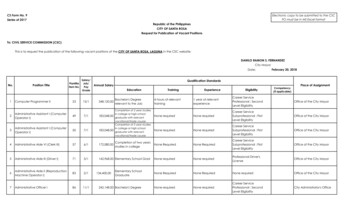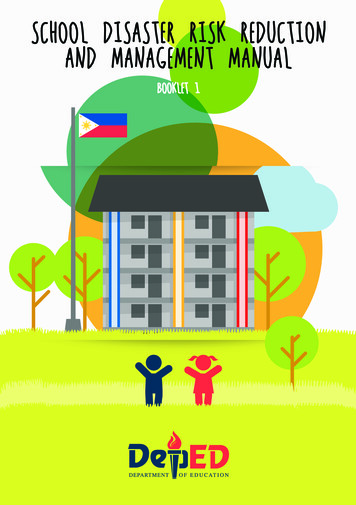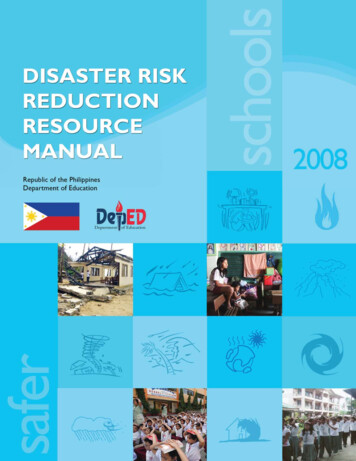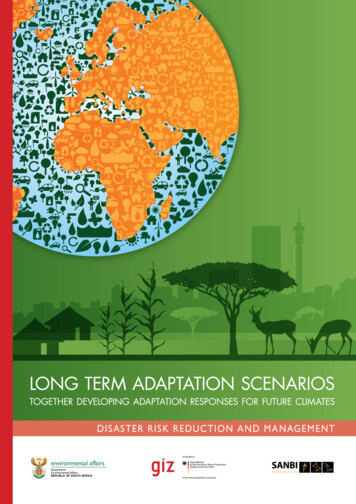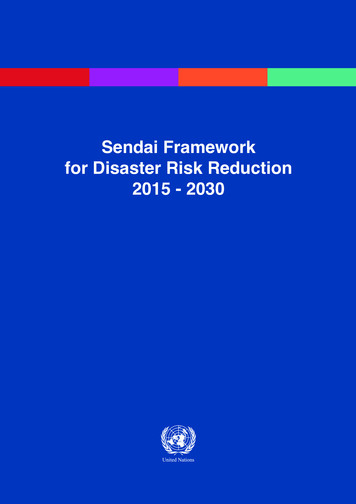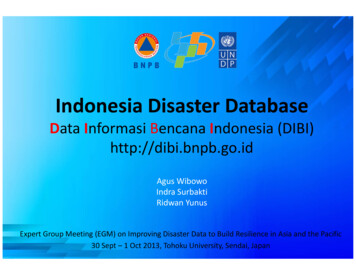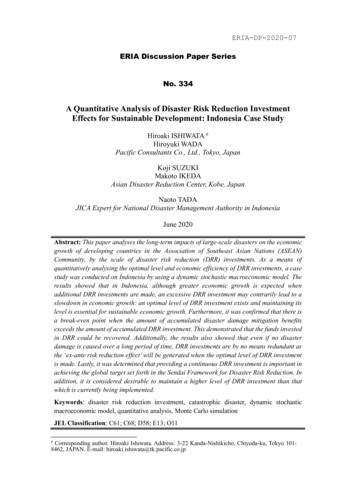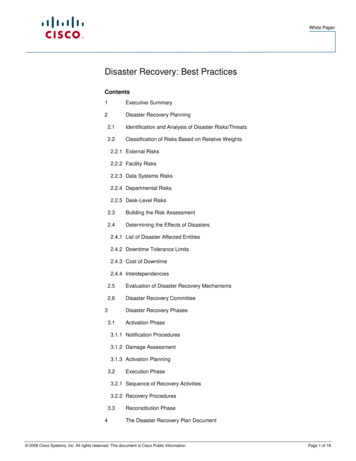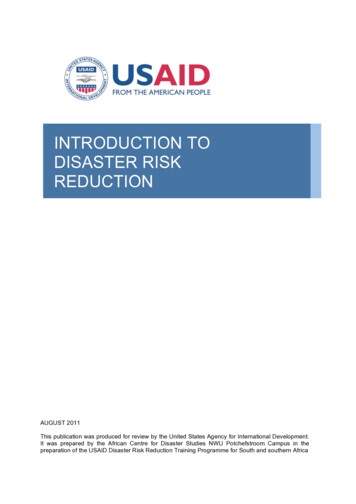
Transcription
INTRODUCTION TODISASTER RISKREDUCTION !AUGUST 2011This publication was produced for review by the United States Agency for International Development.It was prepared by the African Centre for Disaster Studies NWU Potchefstroom Campus in thepreparation of the USAID Disaster Risk Reduction Training Programme for South and southern Africa
INTRODUCTION TO DISASTER RISK REDUCTIONDocument InformationDocument VersionNumberDocument TypeShort TitleLong TitleApplicabilityStatusProjectFunderMain ContributorsAuthor(s)Date of this CompilationCopyright andinstructionsACDS1Learning ModuleIntroduction to disaster risk reductionIntroduction to disaster risk reductionSADCFinalUSAID Disaster Risk Reduction Training Course for Southern AfricaUSAID/OFDADewald van NiekerkDewald van NiekerkAugust 2011This module is licensed under a Creative Commons Attribution-Share Alike 2.5South Africa License.See http://creativecommons.org/licenses/by-sa/2.5/za/ for more detail on the use ofthis material.Any and/or all part of this written work may be copied, changed and adapted to suitthe need of the end-user. This material may NOT be sold for profit. Any changesand adaptations made to this written work must be communicated to the AfricanCentre for Disaster Studies within a period of one calendar month. Seehttp://acds.co.za/index.php?page usaid-project for more informationDisclaimerThis document information must accompany all new versions of this module.Version changes must be indicated by the acronym of the institution undertaking thechanges (e.g. Botswana University : BU.1.1).The author’s views expressed in this publication do not necessarily reflect the viewsof the United States Agency for International Development or the United StatesGovernment.2
INTRODUCTION TO DISASTER RISK REDUCTIONTABLE OF CONTENTS1. INTRODUCTION . 52. DEFINING THE CONCEPTS. 62.1Disaster. 62.2Risk and disaster risk . 92.3Hazard . 102.4Vulnerability . 112.5Coping capacity . 112.6Resilience . 122.6Emergency and disaster management . 132.7Disaster risk reduction . 132.8Disaster risk management. 133. INTERACTION OF HAZARDS, VULNERABILITY AND DISASTER RISK . 144. UNDERSTANDING VULNERABILITY . 164.1Political factors . 164.2Economic factors . 174.3Physical factors. 184.4Social factors . 194.5Environmental factors . 204.6The progression of vulnerability and safety. 215. UNDERSTANDING HAZARDS . 245.1Classification of hazards . 255.1.1 Natural hazards . 255.1.2 Technological hazards . 265.1.3 Environmental Degradation . 265.2Types of hazards . 275.2.1 Slow onset hazards. 275.2.2 Rapid or sudden onset hazards . 275.3Characteristics of hazards. 285.3.1 Permanent characteristics of hazard occurrence. 285.3.2 Temporal characteristics of hazard . 316. THE EVOLUTION OF THE STUDY OF DISASTERS AND RISK . 336.1Social science perspective. 343
INTRODUCTION TO DISASTER RISK REDUCTION6.2Natural science perspective . 356.3Contemporary study of disaster risk . 366.3.1 Constructivism. 366.3.2 Objectivism . 376.4Disaster risk management vs. disaster management. 377. A FRAMEWORK FOR DISASTER RISK REDUCTION. 408.DISASTERS AND DEVELOPMENT . 439. TRANSDISCIPLINARY NATURE OF DISASTER RISK REDUCTION. 4510. DISASTER RISK GOVERNANCE. 4611. CLIMATE CHANGE AND ADAPTATION . 4811.1The causes of climate change. 4911.2Increasing vulnerability through climate change . 4911.3Climate change and disaster risk . 4911.4Climate change adaptation. 5012. GENDER AND DISASTER RISK . 5113. CONCLUSION. 53BIBLIOGRAPHY . 554
INTRODUCTION TO DISASTER RISK REDUCTION1. INTRODUCTIONDisasters have always been a result of human interaction with nature, technologyand other living entities. Sometimes unpredictable and sudden, sometimes slow andlingering, various types of disasters continually affect the way in which we live ourdaily lives. Human beings as innovative creatures have sought new ways in which tocurb the devastating effects of disasters. However, for years human conductregarding disasters has been reactive in nature. Communities, sometimes aware ofthe risks that they face, would wait in anticipation of a disastrous event and thenactivate plans and procedures. Human social and economic development has furthercontributed to creating vulnerability and thus weakening the ability of humans tocope with disasters and their effects.Disasters impede human development. Gains in development are inextricably linkedto the level of exposure to disaster risk within any given community. In the samelight, the level of disaster risk prevalent in a community is linked to thedevelopmental choices exerted by that community (UNDP, 2004). The link betweendisasters and development is well researched and documented. The fact thatdisasters impact on development (e.g. a school being washed away in a flood) anddevelopment increases or decreases the risk of disasters (e.g. introducingearthquake-resistant building techniques) is widely accepted. Yet, every year Africasuffers disaster losses which set back development and leave our communities livingin a perpetual state of risk.Africa has come a long way since the global arena emphasised the need for multistakeholder disaster risk reduction rather than continuing the unsustainable cycle ofdisaster management. The 2000s saw a number of declarations, policies, strategies,plans and programmes developed. Yet very little real implementation of the above isevident on the African continent, despite a number of inter-regional and high-leveldiscussions and forms of collaboration.The following module will introduce you to the field of disaster risk reduction. The firstpart of the module will focus on defining the basic, but most important, terms inrelation to disaster studies. The different elements of disaster risk management willenjoy attention, and how these different elements contribute to our understandingand better management of risk and disasters will be explained. Different types of5
INTRODUCTION TO DISASTER RISK REDUCTIONhazards, vulnerability domains and risks will also be discussed. This module alsoprovides a more theoretical look at the evolution of the study of disasters and indoing so emphasis will be placed on the transdisciplinary nature of disaster riskreduction. After the theoretical foundation for the understanding of disaster riskmanagement has been laid, the emphasis will shift towards an understanding of howdisaster risk management functions as an integrated approach within the context ofsustainable development. The last part of this module will provide you with insightinto some of the cross-cutting issues such as climate change and adaptation,disaster risk governance and gender and disaster risk issues.2. DEFINING THE CONCEPTSVarious terms linked to the activities which we have come to understand as disasterrisk reduction, have evolved and been refined over the past 50 years. An overemphasis on disaster and humanitarian relief has made way for the contemporaryterms such as disaster reduction and disaster risk management. However, acommon understanding of the various terms underlying disaster risk reduction iscrucial if one aims to ensure a standardised approach by all stakeholders. Thesection that follows aims to give perspective on the most important terms used in thefield of disaster reduction. The definition of these terms has been universallyaccepted to be valid and is a compilation of the definitions according to the publishedterminology of the United Nations International Strategy for Disaster Reduction(UNISDR, 2009). UNISDR is the secretariat of the International Strategy for DisasterReduction (ISDR). It was created in December 1999 and is part of the UNSecretariat with the purpose of ensuring the implementation of the InternationalStrategy for Disaster Reduction. An alignment of the terminology used in disasterrisk reduction in Africa with the internationally acceptable concepts is logical.2.1DisasterAlthough the focus of disaster reduction is not on any actual disaster event itself,disaster remains the main focus. Thus our efforts must be geared towards thereduction of the risk of a disaster occurring. Before one can therefore focus on themore technical and complex terms of disaster risk reduction and disaster riskmanagement, one must have a very clear understanding of what in actual fact a6
INTRODUCTION TO DISASTER RISK REDUCTION“disaster” entails.Probably one of the most debated terms in disaster reduction remains the basicdefinition of a disaster. Many scholars (see the work of Quarantelli, 1998b;Quarantelli & Perry, 2005) have expressed diverse views on what exactly constitutesa disaster. Some link the existence of a disaster to a specific amount of lossessustained (e.g. number of people killed and injured), others judge an event to be adisaster if a certain predefined threshold is breached (e.g. a trigger to a certaincontingency measure is reached), some judge disasters on their geographical extentand significance with regard to “normal” conditions, while some express a disaster interms of its monetary value in losses. However, since the International Decade ofNatural Disaster Reduction (IDNDR) the various scientific understandings of disasterhave culminated in a globally accepted definition.The UNISDR (2009) defines a disaster as: “A serious disruption of the functioning ofa community or a society involving widespread human, material, or environmentallosses and impacts which exceeds the ability of the affected community to copeusing only its own resources.”Some aspects of this definition need to be highlighted. Firstly the emphasis of thedefinition is on “a serious disruption”. One can therefore expect a disaster event tobe something which significantly changes the “normal”. It is an event which themajority of the affected community will perceive as removing them from the “normal”.Second and most important is the distinction which the definition places on abnormalevents and an event which we can classify as being a disaster. If the event “exceedsthe ability” of the affected community to handle the consequences by making use ofall their resources, then the event can be classified as “a disaster”. Lastly, noteshould be taken of the concept “community”. Various disciplines define “community”quite differently. A community is a collection of people sharing common interests andvalues. Despite being culturally diverse, mobile or unstable, members of acommunity communicate with or on behalf of each other in order to achieve amutually beneficial outcome – they are bound together by a common goal, theirsense of belonging and a sense of place. However, the management of disastersand the risk associated with disasters in most Southern African DevelopmentCommunity (SADC) countries becomes the responsibility of Government. One7
INTRODUCTION TO DISASTER RISK REDUCTIONshould therefore appreciate the fact that in order for a government to adequatelymanage disasters, the definition of “community” must be very clear. To this end ithas become common practice for governments to use their administrative units todefine the affected “community”. Thus if an event exceeds the coping ability of avillage, or local municipality, or district, or state/province or even the nation, then aspecific type of disaster can be declared (i.e. local, state/provincial or national).The UNISDR goes on to indicate: “Disasters are often described as a resultof the combination of: the exposure to a hazard; the conditions of vulnerability thatare present; and insufficient capacity or measures to reduce or cope with thepotential negative consequences. Disaster impacts may include loss of life, injury,disease and other negative effects on human physical, mental and social well-being,together with damage to property, destruction of assets, loss of services, social andeconomic disruption and environmental degradation.”It is important to note that the term “natural disaster” has not been used, the reasonbeing it is inaccurate and misleading to refer to “natural disasters”.Disasters: Natural or not?Disaster risk can be determined by the presence of three variables: hazards (naturalor anthropogenic); vulnerability to a hazard; and coping capacity linked to thereduction, mitigation and resilience to the vulnerability of a community associatedwith the hazard in question. For example, let’s assume we are dealing with a poorAfrican community (i.e. an informal settlement situated in the 1/50 year flood-line).Certain socio-economic and political dynamics in the country force poor communitiesto settle in unsafe conditions (e.g. distance from employment opportunities,urbanisation, poor land use planning etc.). Along comes a natural hazard such as asignificant flood, and the community settled in the flood-line is exposed to the point ofexperiencing a disaster. However, this should not be seen as a natural disaster.Although a natural hazard was the trigger for the disaster, it was in fact humanmade. If proper settlement planning, land use planning, building codes, communityawareness, economic policies, and the like had been in place, then this “naturaldisaster” would have been mitigated. Almost all exposure to natural hazards andvulnerability can be reduced. Thus human actions lead to natural hazards becoming8
INTRODUCTION TO DISASTER RISK REDUCTIONnatural disasters. One should be mindful that we as humans do not have absolutecapacity and have sustained and will sustain significant losses due to naturalhazards in future. We however need to realise that we also have capacity to makethe right decisions, implement the right measures, and engage in intelligentdevelopment planning which will reduce the risk of disasters occurring. The reductionof a risk manifesting in a disaster therefore requires a very broad multi-sectoral andmultidisciplinary focus where the structural engineer, politician, social worker,agricultural extension worker and even kindergarten teacher all have equallyimportant roles in ensuring natural hazards do not become disasters.The above example highlighted a number of other terms which are important tounderstand to gain a full picture of what disaster risk reduction entails.2.2Risk and disaster riskRisk has various connotations within different disciplines. In general risk is definedas “the combination of the probability of an event and its negative consequences”(UNISDR, 2009). The term risk is thus multidisciplinary and is used in a variety ofcontexts. Risk is usually associated with the degree to which humans cannot cope(lack of capacity) with a particular situation (e.g. natural hazard).The term disaster risk therefore refers to the potential (not actual and realised)disaster losses, in lives, health status, livelihoods, assets and services, which couldoccur in a particular community or society over some specified future time period.Disaster risk is the product of the possible damage caused by a hazard due to thevulnerability within a community. It should be noted that the effect of a hazard (of aparticular magnitude) would affect communities differently (Von Kotze, 1999:35).This is true because of the level of the coping mechanisms within that particularcommunity. Poorer communities are therefore more at risk than communities that dohave the capacity to cope.Risks exist or are created within social systems. The social context in which riskoccurs is an important consideration. It should also be noted that people therefore donot share the same perceptions of risk and their underlying causes due to their socialcircumstances. To determine disaster risk three aspects need to be present: a9
INTRODUCTION TO DISASTER RISK REDUCTIONhazard, vulnerability to the hazard and some form of coping capacity. These termswill now enjoy greater attention.2.3HazardA hazard is defined as “a dangerous phenomenon, substance, human activity orcondition that may cause loss of life, injury or other health impacts, property damage,loss of livelihoods and services, social and economic disruption, or environmentaldamage” (UNISDR, 2009).Hazards can be single, sequential or combined in their origin and effects. Eachhazard is characterised by its location, intensity, probability and likely frequency.Typical examples of hazards can be the absence of rain (leading to drought) or theabundance thereof (leading to flooding). Chemical manufacturing plants nearsettlements can also be regarded as hazardous; similarly, incorrect agriculturaltechniques will in the long run lead to possible disasters. Hazards can either be acreation of humans (anthropogenic) or the environment (natural). Although the formercan more easily be planned for than the latter, in both cases the management of thehazard will remain the same. Our development efforts and attention should thereforebe focused on the presence of various hazards and this must inform our planning.A distinction should also be made between normal natural occurrences and naturalhazards. Natural phenomena are extreme climatological (weather), hydrological(water), or geological (earth) processes that do not pose any threat to persons orproperty. A massive earthquake in an unpopulated area (e.g. the Sahara desert) is anatural phenomenon. Once the consequences (a possible hazardous situation) ofthis natural phenomenon come into contact with human beings it becomes a naturalhazard. If this natural hazard (due to the unplanned or poorly planned activities of thehuman beings), affects them so that they are unable to cope, the situation becomesa disaster.Difference between a hazard and a disaster“Strictly speaking there are no such things as natural disasters, but there are naturalhazards. A disaster is the result of a hazard’s impact on society. So the effects of adisaster are determined by the extent of a community’s vulnerability to the hazard(conversely, its ability, or capacity to cope with it). This vulnerability is not natural, but10
INTRODUCTION TO DISASTER RISK REDUCTIONthe result of an entire range of constantly changing physical, social, economic,cultural, political and even psychological factors that shape people’s lives and createthe environments in which they live.” Twigg (2001:6).2.4VulnerabilityVulnerability is defined as the characteristics and circumstances of a community,system or asset that make it susceptible to the damaging effects of a hazard.Vulnerability is a set of prevailing or consequential conditions arising from variousphysical, social, economic and environmental factors which increase thesusceptibility of a community to the impact of hazards (UNISDR, 2002:24). It canalso comprise physical, socio-economic and/or political factors that adversely affectthe ability of communities to respond to events (Jegillos, 1999). Blaikie et al. (1994)are of the opinion that vulnerability is constituted by the characteristics of a person orgroup in terms of their capacity to anticipate, cope with, resist and recover from theimpact of a hazard. Vulnerability can be expressed as the degree of loss resultingfrom a potentially damaging phenomenon or hazard. It is therefore the extent towhich a community will degrade when subjected to a specified set of hazardousconditions.Vulnerability has some distinct underlying causes. The magnitude of each disaster,measured in deaths, damage, or costs (for a given developing country) increaseswith the increased marginalisation of the population. This can be caused by a highbirth rate, problems of land tenure and economic opportunity, and the misallocationof resources to meet the basic human needs of an expanding population. As thepopulation increases, the best land in both rural and urban areas is taken up, andthose seeking land for farming or housing are forced to accept inadequate land. Thisoffers less productivity and a smaller measure of physical or economic safety, thusrendering the community vulnerable.2.5Coping capacityCoping capacity for disaster risk reduction refers to the ability of people,organisations and systems, using available skills and resources, to face and manageadverse conditions such as hazards, emergencies or disasters. Coping capacitiescontribute to the reduction of disaster risks (UNISDR, 2009). The focus here should11
INTRODUCTION TO DISASTER RISK REDUCTIONtherefore not only be on the individual or the community but also the capacity of thesupporting mechanisms to the individual and the community at large. For example,one specific community might consist of a number of new immigrants but this newcommunity might enjoy the support of the local municipality. In themselves the newcommunity might not have cohesion yet, but their capacity lies in the support whichthey have. Similarly an impoverished community might not be the focus ofdevelopment, but inherent in their internal social and economic structures they mightpossess significant coping capacity and resilience. Coping capacity is therefore justas much about what a community internally possesses, as the external structures onwhich they depend.2.6ResilienceIn the natural environment, resilience means that an area or eco-system under threatis restored to its original pristine state. In the construction and engineering industry,resilience would be the ability of metal or a structure to return to an original state –being able to withstand shock, weight or pressure. However, human systems cannotbe untouched by life events – they do not necessarily return to an original or formerstate and the challenge is to continuously develop, improve and refine existingstructures, systems and environments in order to progress. Returning to an originalor previous state therefore corresponds with the tendency of certain communities toreturn to vulnerable locations and rebuild their houses, without improving conditionsand increasing chances to progress. Resilience, however, implicitly requiresimprovement.The UNISDR defines resilience as “the ability of a system, community or societyexposed to hazards to resist, absorb, accommodate to and recover from the effectsof a hazard in a timely and efficient manner, including through the preservation andrestoration of its essential basic structures and functions” (UNISDR, 2009). Thisdefinition therefore considers the presence of a hazard and not a disaster. Thusonce a disaster actually occurs, it would be incorrect to refer to resilience but ratherto coping capacity. Resilience and the building of resilience should therefore be seenas an integral part of disaster risk reduction activities.Resilience therefore means the ability to “spring back from” a shock. The resilienceof a community in respect of potential hazard events is determined by the degree to12
INTRODUCTION TO DISASTER RISK REDUCTIONwhich the community has the necessary resources and is capable of organising itselfboth prior to and during times of need (UNISDR, 2009).2.6Emergency and disaster managementThis involves: “The organisation and management of resources and responsibilitiesfor addressing all aspects of emergencies, in particular preparedness, response andinitial recovery steps. An emergency is a threatening condition which requires urgentaction. Effective emergency action can avoid the escalation of an event into adisaster. It involves plans and institutional arrangements to engage and guide theefforts of government, non-government, voluntary and private agencies incomprehensive and coordinated ways to respond to the entire spectrum ofemergency need” (UNISDR, 2009).The expression “disaster management” is sometimes used instead of emergencymanagement. The later discussion (see section 6.4) of disaster management anddisaster risk management aims to put disaster management in perspective.2.7Disaster risk reductionDisaster risk reduction (also referred to as just disaster reduction) is defined as theconcept and practice of reducing disaster risks through systematic efforts to analyseand manage the causal factors of disasters, including through reduced exposure tohazards, lessened vulnerability of people and property, wise management of landand the environment, and improved preparedness for adverse effects. Disasterreduction strategies include, primarily, vulnerability and risk assessment, as well as anumber of institutional capacities and operational abilities. The assessment of thevulnerability of critical facilities, social and economic infrastructure, the use ofeffective early warning systems, and the application of many different types ofscientific, technical, and other skilled abilities are essential features of disaster riskreduction.2.8Disaster risk managementDisaster risk management is the systematic process of using administrativedirectives, organisations, and operational skills and capacities to implementstrategies, polices and improved coping capacities in order to lessen the adverse13
INTRODUCTION TO DISASTER RISK REDUCTIONimpacts of hazards and their possibility of disaster. Disaster risk management aimsto avoid, lessen or transfer the adverse effects of hazards through activities andmeasures for prevention, mitigation and preparedness (UNISDR, 2009).The interaction between disaster risk reduction and disaster risk management isclear. Disaster risk reduction concerns activities more focused on a strategic level ofmanagement, whereas disaster risk management is the tactical and operationalimplementation of disaster risk reduction.3. INTERACTION OF HAZARDS, VULNERABILITY ANDDISASTER RISKIn the previous section you were able to develop an understanding of core conceptswhich included the terms hazard, vulnerability and disaster risk. In this section wewill examine how the interaction between hazards and vulnerability translate intodisaster risk. In the process, we will identify the political, economic, physical, social,and ecological factors that interact to increase the susceptibility of individuals,households and communities to the impact of hazards. The identification of thesefactors provides the basis for the prioritisation of initiatives which will contribute toreducing vulnerability and thus to eliminating and/or reducing disaster risk. Theinitiatives so prioritised should then be integrated by the various spheres ofgovernment into sustainable development and disaster risk reducti
INTRODUCTION TO DISASTER RISK REDUCTION 5 1. INTRODUCTION Disasters have always been a result of human interaction with nature, technology and other living entities. Sometimes unpredictable and sudden, sometimes slow and lingering, various types of disasters continually affect the way in which we live our daily lives.
